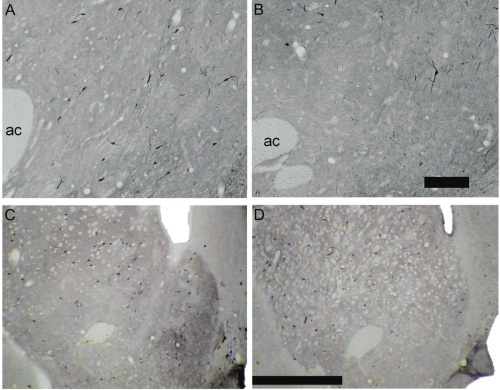Contributed by François LaPlante. Dept of Psychiatry, McGill University, Montréal, QC, Canada
A post-mortem reduction in the density of cholinergic interneurons in the ventral striatum or nucleus accumbens (N.Acc.) has been reported in schizophrenic brains.[1,2] In this region the cholinergic interneurons interact anatomically and functionally with the dopaminergic nerve terminals notably to dampen the effects of excessive dopamine activity. We hypothesized that the lower level of cholinergic neurons and subsequently the acetylcholine release in the N.Acc may be relevant to the enhanced (ventral) striatal dopaminergic neurotransmission, well-described in schizophrenia, and may contribute to the emergence of schizophrenic symptoms.
The purpose of our work is to reproduce in rats the selective reduction of cholinergic interneurons in the N.Acc. and study the physiological and behavioral consequences of such lesions with relevance to schizophrenia. We employed the saporin immunotoxin targeting choline acetyltransferase (anti-ChAT-SAP; Cat. #IT-42), microinjected bilaterally (250-ng/side) into the N.Acc. of adult Sprague-Dawley rats. We found a localized and selective 40-50% loss of cholinergic interneurons (minimum two weeks post-lesion) with sparing of adjacent areas.[3] Similarly, the toxin infusion resulted in a 34% reduced tissue level of acetylcholine in the N.Acc.
We have previously shown that partial depletion of cholinergic neurons resulted in heightened behavioral sensitivity to amphetamine and impaired sensorimotor function[3] analogous to those seen in schizophrenia. Recently we observed that such lesions also significantly impaired performance in a T-maze task, a measurement of working memory. In addition, in vivo activation of dopamine release in the prefrontal cortex was markedly reduced; this deficit correlated significantly with cognitive impairments.[4] These data suggest that intra-accumbens lesions of the cholinergic neurons trigger not only a local hyper-responsiveness to dopamine but also widespread functional impairments in prefrontal cortical dopamine functions similarly as proposed in the pathology of schizophrenia. Studies to describe mechanistic consequences of cholinergic lesions on dopamine neurotransmission are in progress. Additionally, as ChAT spends time on the membrane, it can be used to target cholinergic neurons.[5]
 |
Figure 1.Representative sections of ChAT-immunostained tissues of N.Acc. from rats that (A and C) received an intra-accumbens micro-injection of rabbit IgG-SAP (Cat. #IT-35; 250 ng) as control group, and (B and D) received an intra-accumbens micro-injection anti-ChAT-SAP (250 ng).The administration of anti-ChAT-SAP reduced significantly the amount of cholinergic interneurons at the injection site and spared the adjacent areas like the dorsal striatum.Scales A and B = 200 μm; C and D = 1 mm; ac: anterior commissure. |
References: (back to top)
- Holt DJ, Herman MM, Hyde TM, Kleinman JE, Sinton CM, German DC, Hersh LB, Graybiel AM, Saper CB. 1999. Evidence for a deficit in cholinergic interneurons in the striatum in schizophrenia. Neuroscience 94:21-31.
- Holt DJ, Bachus SE, Hyde TM, Wittie M, Herman MM, Vangel M, Saper CB, Kleinman JE. 2005. Reduced density of cholinergic interneurons in the ventral striatum in schizophrenia: an in situ hybridization study. Biol Psychiatry 58:408-416.
- Laplante F, Lappi DA, Sullivan RM. 2011. Cholinergic depletion in the nucleus accumbens: Effects on amphetamine response and sensorimotor gating. Prog Neuropsychopharmacol Biol Psychiatry 35:501-509.
- Laplante F, Zhang ZW, Huppe-Gourgues F, Dufresne MM, Vaucher E, Sullivan RM. 2012. Cholinergic depletion in nucleus accumbens impairs mesocortical dopamine activation and cognitive function in rats. Neuropharmacology 63:1075-1084.
- Badamchian M and Carroll PT. 1985. Molecular weight determinations of soluble and membrane-bound fractions of choline O-acetyltransferase in rat brain. J Neurosci 5(8):1955-1964.
